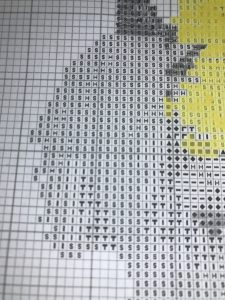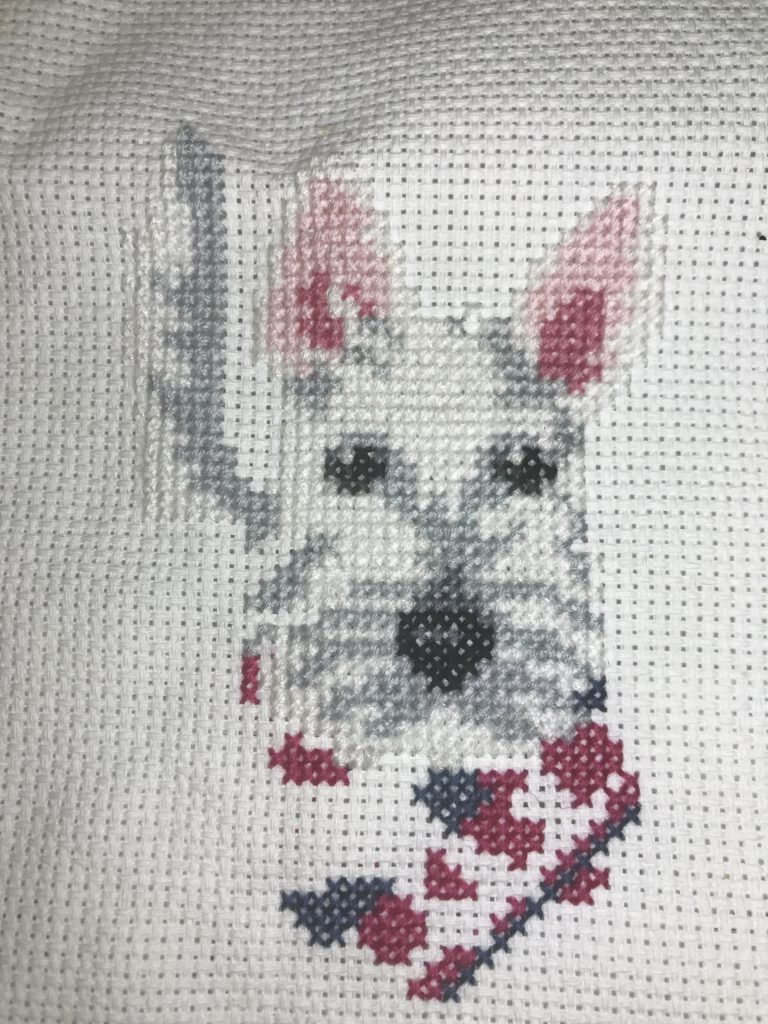A couple of weeks ago, I got the urge to cross stitch something. I’m not entirely what prompted that, but I’m glad it did. I’ve been having quite a bit of fun creating my image.
The first thing I did was to go out and purchase a piece of Aida fabric. This is a precut piece of fabric that is punched with holes (imagine a very small, fabric instead of paper, version of a “boxes” game). The weave on the fabric is reasonably loose – you can easily see the threads. But at the same time, the fabric is stiff. To make your design, you create a series of little Xs, using the holes in the fabric as your guide.
If you don’t know how to read a cross stitch pattern, they seem like gibberish, so let me take a moment to explain it to you.
First, you have to understand embroidery thread. Embroidery thread comes in tiny skeins, and you have to re-wind it onto bobbins before you use it. Each one is reasonably short, so it only takes a minute or two to wind one. The thread is made up of six thin strands. For most forms of cross stitch and embroidery, you use two of those strands at a time. This means that you have to cut a length of thread off of your bobbin (usually 12-18 inches), and then peel apart two of the strands from the rest. Alternately, you can peel off just one strand and fold it in half (this is normally what I do). This allows you to cut your thread a bit longer because you’re just going to halve it. You don’t want to cut your thread too long because you risk easy knotting otherwise. Also, embroidery thread doesn’t have color names; it has color numbers. This makes it easier to find the exact colors you need for a specific pattern. There are two main brands of the thread that I know of, but almost all patterns only offer the color numbers for one of them: DMC.
 Now that you know about the thread itself, we can move back to the patterns. On your pattern, you’ll see a key that’s not unlike a map legend. It shows all the different symbols used in the pattern, and next to each one is a color number and sometimes description of the color. This allows you to easily shop for the threads you need for your project. (You don’t have to take these colors as canon; I’ve frequently adjusted the colors based on what I already have on hand or in the event that the store is out of a color that’s required in the pattern.)
Now that you know about the thread itself, we can move back to the patterns. On your pattern, you’ll see a key that’s not unlike a map legend. It shows all the different symbols used in the pattern, and next to each one is a color number and sometimes description of the color. This allows you to easily shop for the threads you need for your project. (You don’t have to take these colors as canon; I’ve frequently adjusted the colors based on what I already have on hand or in the event that the store is out of a color that’s required in the pattern.)
When you’ve gathered all of your supplies – the different threads, the Aida fabric, a needle (cross stitch needles are blunt because the fabric has holes already; this makes it a good past time to teach children), and a pair of scissors – you’re ready to stitch! You always start a cross stitch in the center and work your way out. This keeps your design centered on your fabric, which makes it easier to frame later. The pattern will guide you toward that center point with arrows on the edge. You just follow the arrows inward and choose the best match you see. Again, this isn’t a precise science. I normally narrow it down to 4 possible stitches and pick the one I want to start with.
As you might have guessed from what I’ve said thus far, each symbol represents one color of thread. You simply create the little X on your fabric using the appropriate color. I find it easiest to work in “chunks” of a single color and then move on to another color. Some people like to work in rows, keeping their color attached until they need it again. Neither way is right or wrong; like all crafts, so long as it looks right in the end – and you’re happy with it – then you did it right. One last tip, though: always mark off the stitches you’ve already created in thread. I can’t imagine a universe in which avoiding doing that would be beneficial, even for an experienced stitcher. You can either print out your pattern and mark off the stitches with a pencil, or work digitally and mark them off using some sort of highlighting tool in your PDF reader of choice (I use iBooks on my phone).
Now that you’ve (hopefully) got a basic idea of how to cross stitch, here’s my current project.
I don’t like dogs as a general rule, but Scotties have always been an exception to that rule! (At least as decor. I’m not sure I’d ever want a real dog, no matter how cute.)
Do you cross stitch? Do you like dogs?
Blessings,


